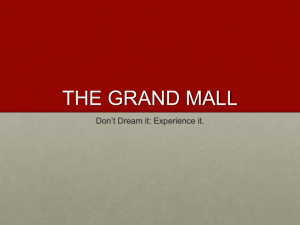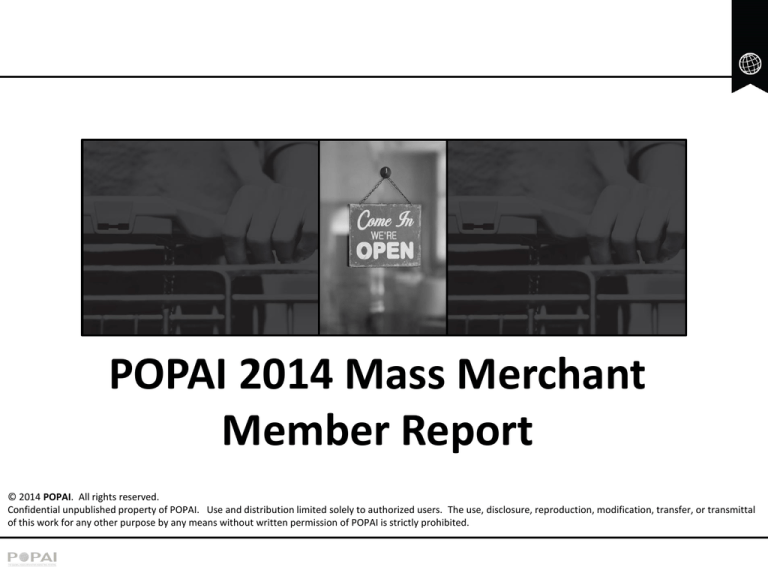
POPAI 2014 Mass Merchant
Member Report
© 2014 POPAI. All rights reserved.
Confidential unpublished property of POPAI. Use and distribution limited solely to authorized users. The use, disclosure, reproduction, modification, transfer, or transmittal
of this work for any other purpose by any means without written permission of POPAI is strictly prohibited.
Methodology
Entry Interviews/Pre-Shop
• 2,991 shoppers ages 18 years or older were screened for living in a household without members in the
advertising, market research, grocery or mass merchandising industries.
• Interview included questions about planned category and brand purchases which were documented from
shopping lists or shopper recall. General shopping information was captured as well.
• Shoppers were asked to return at the conclusion of their shopping trip for a follow-up exit interview with a
team member.
Exit Interviews/Post-Shop
• Post-shopping exit interviews probed on items purchased and gathered shopper perceptions of the store’s
shopability and attitudes towards the shopping experience.
• Register receipts were scanned in order to capture and code all purchase information down to the brand level.
A comparison of reported pre-store planned items and actual purchases is at the core of this study. Over
21,000 purchases were recorded.
• Demographic and profiling information were captured as well.
Eye-Tracking
• A sub-set of 219 shoppers from the 2,955 who passed the screening criteria and agreed to wear eye-tracking
headwear were directed to the eye-tracking team who set up each shopper prior to entering the store.
Shoppers were asked to embark on their trip and shop the store as they normally would.
Display Audit
• Prior to conducting the shopper intercept interviews, ethnographers logged and
audited every characteristic in each store
• The purpose was to evaluate channel trends and the overall influence of displays
• The audit also included a photo of each displays and was coded for the following:
DISPLAY TYPES:
-END-CAP
-IN-LINE
-POWERWING/SIDEKICK
-FLOOR STAND
-DEMO DISPLAYS
LOCATION OF EACH DISPLAY:
END OF AISLE
• Back-of-Store
• Center-of-Store
• Front-of-Store
IN-AISLE
RACETRACK
•
•
•
•
Back-of-Store
Center-of-Store
Front-of-Store
Side
PLACEMENT
• Secondary
• Primary
CHARACTERISTICS
•
•
•
•
•
Static
Integrated
Motion
Freestanding
Interactive
EYE TRACKING METHODOLOGY
• To compliment the interview data, POPAI also used eye-tracking to provide additional
insight into the shopper journey
• Eye tracking was done in 2 store for each Mass Merchant chain (total of 6 stores)
• Objectives for eye tracking were:
• Understand shopper behavior, in particular their reaction and interactions to/with
the displays in-store
• Measure shopper behavior as shopper naturally shop
• Observe and measure shopping behavior providing measurements at:
• Shopper Path
• Category/Shelf
• Display Engagement
• Integrate shopper behavior results with self-reported pre-and-post surveys
Shopper Trip Planning: List Type
• Nearly half of all mass merchant shopper have some sort of a mental list, supporting the
opportunity for visual in-store marketing cues to “remind” shoppers
• 34% of all mass shoppers enter the store with no list at all, a significant difference from
grocery shoppers
Mental List
Written List
A
47% vs. 48%
15% vs. 36%
2014-Mass Merchant
Digital List
No List
E
E
5% vs. 3%
34% vs. 13%
2012-Grocery
Sig. differences noted using 95% confidence
A: Total Mass E: Grocery
PL3. What kind of shopping list did you prepare today?
5
Shopper Trip Planning: Pre-Store Media Use
Shoppers within the Mass Merchant channel do less pre-store planning and research than
grocery shoppers suggesting there is more opportunity for in-store purchase decisions
Television Advertising
2% vs. 2%
Info received in mail/newspaper
18% vs. 23%
Info from any coupon
14% vs. 25%
Info via electronic sources
9% vs. 30%
Store circular/Print advertising
21% vs. 30%
None
62% vs. 55%
2014-Mass Merchant
•
2012-Grocery
PL4. Which of the following did you use to plan your shopping trip today?
6
Shopper Trip Planning: Category Planning
TOP SPECIFICALLY MASS MERCHANT PLANNED SUB-CATEGORIES:
• Mass Merchant shoppers plan for a mix of both grocery and non-grocery items, however
the top three-planned sub-categories are within the grocery product mix
• Insight: Brands within these categories may potentially have to try harder to win the
purchase conversion at the shelf as they are most planned product categories
Entrée Shelf Stable
75%
Fresh Fruit
74%
2014-Mass Merchant
•
PP1. For the first planned product mentioned did the shopper purchase the:
Fresh Vegetable
73%
Shopper Trip Planning: Category Planning
TOP LEAST MASS MERCHANT PLANNED CATEGORIES:
• A mix of both grocery and non-grocery items fall within the top least planned categories
in the Mass channel
• Insight: Many of these categories are considered “non-essential” and are considered to
be “fun” categories which stress the importance of placing them on displays to call out
easily influenced shoppers
Magazines
97%
Energy Drinks
85%
2014-Mass Merchant
•
PP1. For the first planned product mentioned did the shopper purchase the:
Packaged Sweet Baked Goods
83%
Shopper Trip Planning: Trip Type
Prior to the shopping trip shoppers were asked to distinguish their shopping trip between the
following trip types:
1. If there were there research products with no specific purchases planned: 12%
2. If there were at the store to pick up one or two specifically planned items: 58%
3. If there were at the store to pick up several items: 30%
Additionally shoppers were asked if they were planning to buy ANY groceries and to classify the
trip
Quick Trip
62% vs. NA
Fill-In
23% vs. 74%
2014-Mass Merchant
S6. Which one of the following statements best describes the primary purpose of your overall shopping trip today?
S7b. Which one of the following statements best describes the purpose of your GROCERY shopping trip today?
Stock Up
15% vs. 26%
2012-Grocery
Average Basket Size For Mass Trips
• Due to the nature of the Mass Merchant channel a variety of trips were accounted for
• Notably even shoppers who had no intention to purchase any products emerge from
Mass stores with an average of at least 4 products
4
Here to browse or
research products-no
specific purchases planned
6
Here to pick up just one or
two specifically planned
items
15
Here to pick up several or
many items that you
planned to buy
Average Basket Size Grocery Shoppers
• Overall Mass Merchant shoppers a larger basket size compared to their 2012 Grocery
counterparts
Average Basket Size For Grocery Shoppers
11
Fill-In Trips of more than
just a few items that I need
before my next stock-up
Quick trip to get a few
items that I need now
17
N/A
10
19
24
Routine stock-up trip
2014-Mass Merchant
2012-Grocery
I
Trip Length & Accompanying Shoppers
The fact that mean spend more time in the grocery store than mass retailers is likely not due to the
greater difficult in the store, as both men and women give significantly higher ease of shopping
scores to grocery store categories. Rather, the greater amount of time is probably due to the
greater number of purchases made in grocery.
34
31
30
31
32
30
31
31
34
26
30
34
33
26
21
22
Mass (N=2952)
Grocery (N=2401)
Men alone
Men with Men with
Females
Women
kids only other adults with kids with adults
only
only
and children
Women
alone
Men with
Women
adults and with other
children adults only
Sig. differences noted using 95% confidence
A: Mass; E: Grocery
OB2. Ethnographer: Indicate Shoppers Gender
OB3. Is the shopper alone or accompanied by others? ((Single Select))
OB4/5. Ethnographer, please indicate the gender/age range of the persons accompanying the shopper.
CS6.1. How easy or difficult was it for you to shop the <<CS1a>> section?
12
In-Store Decision Rate
• The In-Store Decision Rate for the Mass Merchant Channel is 82%
• Although the in-store decision rate continues to climb to a high of 82% the difference in
channel should be accounted for the difference. Since mass merchant shoppers spend less
time conducting pre-store research and frequently walk in without a list it is not surprising the
in-store rate is so high
Purchase Decisions Over Time
66%
70%
54%
34%
62%
60%
76%
55%
82%
30%
24%
18%
15%
10%
2%
Grocery 1986
6%
4%
6%
Grocery 1995
Grocery 2012
Specifically Planned
In-Store Decision Rate
Generally Planned
Substitute
17%
3%
Mass 2014
Unplanned
In-Store Decision Rate: Gender
Implication: Although the gender gap is not large, women are more likely than
men to make some or all of their purchase decision in the Mass Merchant Store
29%
24%
28%
18%
71%
76%
72%
82%
2012 Grocery
2014 Mass Merchant
2014 Planned Purchase
2012 Planned Purchase
2014-In-Store Decision
2012-In-Store Decision
Sig. differences noted using 95% confidence
A: Male; B: Female
•
2012 Grocery
PP1. For the first planned product mentioned did the shopper purchase the:
2014 Mass Merchant
In-Store Decision Rate: Age
• Although there is not a strong correlation between age in the Mass Merchant channel, a strong correlation
exists with in-store decision rates declining with age in the 2012 Grocery data
• This should be kept in mind when promoting and display products for older adults
75+
In-Store
Planned
In-Store
Planned
78%
22%
71%
29%
65-74
81%
19%
73%
27%
55-64
80%
20%
74%
26%
45-54
82%
18%
77%
23%
35-44
83%
17%
79%
21%
25-34
82%
18%
75%
25%
18-24
83%
17%
75%
25%
2014 Mass In-Store
2014 Mass Planned
2012 Groery In-Store
2012 Grocery Planned
Brand Conversion
• Despite the large variety of product choice shoppers have in the store many of today’s brands
received over 50% for in-store conversion
• However the absence of full conversion suggests the power of in-store marketing and the importance
of placing products on display in the store to motivate easily swayed shoppers
2014 Top 10 Brand Mentions and Conversion
BRAND
COMPLETED PURCHASE
BRAND
COMPLETED PURCHASE
Kraft
90%
Pepsi
76%
Kellogg’s
85%
Dove
71%
Purina
85%
Pampers
68%
Colgate
78%
Tide
67%
Charmin
77%
Coca-Cola
65%
Shopper Segments: The Formation
Shoppers are clustered into segments to understand the attributes and characteristics that are most
important as they decide where to shop through the following steps:
• Shoppers were asked to rate their level of agreement with a broad set of lifestyle and shopping
characteristics on a five-point scale
• Factor analysis was used to create shopper groups based on these lifestyle and shopping statements
• These factor groupings form the basis of the creation of shopper segments, which can be analyzed
for shopping behavior patterns, price sensitivity, retailer preferences, retailer loyalty, demographic
differences, and opportunities for conversion
• The factor analysis yielded four unique segments, each defined by their purchase drivers
• These segments have unique attitudes and behaviors as they relate to their shopping patterns and
retailer selection
Shopper Segments: Breakout
EXPLORER
TIME STRESSED
BARGAIN HUNTER
TRIP PLANNER
29% vs. 27%
23% vs. 23%
22% vs. 24%
26% vs. 26%
Average Basket: $54
Average Basket: $44
Average Basket: $48
Average Basket: $39
83% In-Store
Decision Rate
82% In-Store
Decision Rate
81% In-Store
Decision Rate
81% In-Store
Decision Rate
Describe
themselves as
easily tempted
Describe
themselves as
impulsive
Describe
themselves as
controlled and
restrained
Describe
themselves as
controlled and
planner
2014-Mass Merchant
2012-Grocery
18
Display Placement
• Compared to the 2012 study, one immediate difference can be seen in the placement of displays
• In 2012 over half of all displays were found in secondary locations, however in the 2014 study an
overwhelming amount are placed in the primary aisle
Location of Display
76%
55%
45%
Primary
Secondary
24%
2012 Grocery
2014 Mass
Display Placement
• Similar to the 2012 Grocery study, displays placed at the end of aisle remain popular with
almost half of all 2014 Mass Merchant displays
Location In-Store of Display
48%
42%
38%
28%
2014 Mass
23%
2012 Grocery
14%
7%
End of Aisle
In-Aisle
Racetrack
Perimeter
Front End
Type of Display
•
The 2012 Study found that Floor stands were favored more than any other type of display,
however in the 2014 Mass Merchant study it was seen that end caps are overwhelming used by
brands
Display Type
2012 Grocery
2014 Mass
End Cap
31%
77%
In-Line
13%
10%
Powerwing/Sidekick
2%
6%
Floor Stand
52%
4%
Demo Display
N/A
3%
In-Store Media
2%
N/A
Display Lift Index
The average display lift for the Mass
Merchant Channel is 1.5
Top Display Lift Categories
Battery
17.4
Makeup
14.7
Toothpast
7.1
e
Candy
4.1
22
Demographics: Household Income
• The annual household income has decreased from the 2012 Grocery sample
• Within the Mass Merchant Channel 70% have a household income of $35,000 or
more compared to 75% in 2012
Household Income
30%
29%
24%
23%
19%
19%
17%
14%
11%
10%
3%
Under $35,000
$35,000-$54,999
$55,000-$74,999
2012 Grocery
$75,000 +
2014 Mass Merchant
Declined
2%
Don't Know
Demographic: Education Level
•
A shift in the education profile of shoppers can be seen with 49% of Mass Merchant
shoppers holding a college degree or higher, compared to the 54% in 2012
Education Level
33%
30%
30%
27%
17%
1%
19%
19%
19%
3%
Less Than High School
3%
0%
High School Graduate
Some College
2012 Grocery
College Graduate
2014 Mass Merchant
Advanced Degree
Declined
Demographic: Employment
• The full-time workforce has increased from 50% in 2012 to 54% in 2014
Employment
54%
50%
19%
12% 12%
11%
4%
4%
Working Full Time Working Part Time Looking for a Job
2012 Grocery
4%
7%
9%
9%
2%
Student
Retired
2014 Mass Merchant
Taking Care of
Household
4%
Other
Demographic: Ethnicity
• The 2014 sample is more ethnically diverse than the 1995 and 2012 study, with
65% White/Caucasian compared to 75% in 2012 and 85% in 1995
75%
65%
3% 5%
11% 14%
8% 10%
2012 Grocery
3%
2014 Mass Merchant
2%
3%

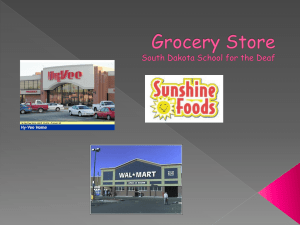
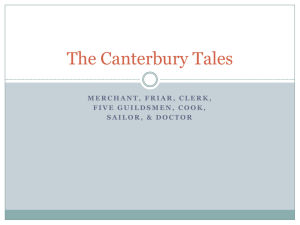
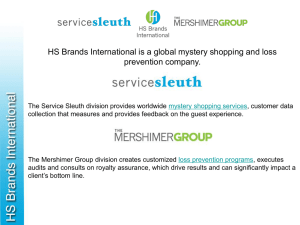

![platinum_presentation[1]](http://s2.studylib.net/store/data/005222927_1-20b6c53250f6dd80de50e457d09553b6-300x300.png)




